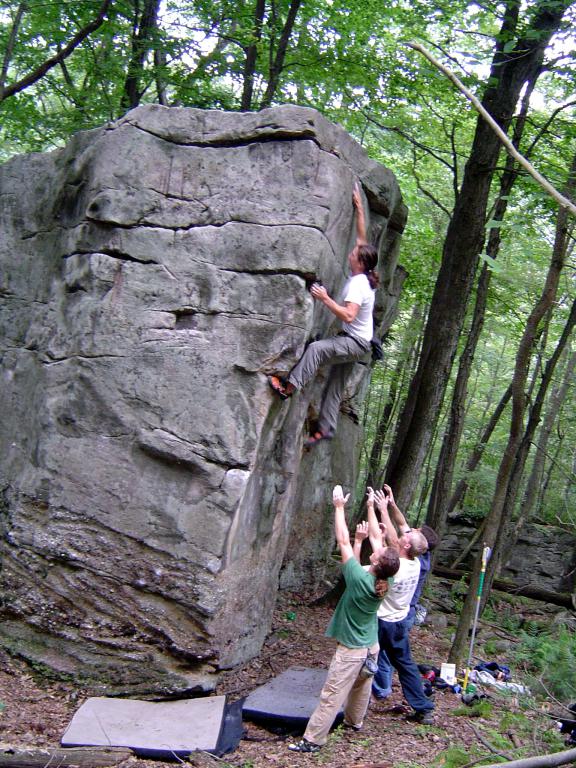Plastic to Rock: Safely Adapting to Climbing Outside
By Dana Harrington
With the increasing popularity of indoor climbing, more and more people have developed a passion for grappling plastic holds, and scaling man-made climbing walls. Naturally, some of these urban adventurers are interested in taking their new skills outside and getting a taste for climbing on real rocks. However, the world of outdoor climbing is not as simple as signing a waiver and renting some shoes. It requires a higher level of knowledge and commitment to safely adapt to climbing outside. There is a great deal of risk to manage, and without specialized gear (and the skill to use it) you expose yourself to injury–or worse. Here in the PA Wilds, bouldering provides a good transition. With bouldering you don’t have to worry about ropes, harnesses, carabiners, or knots. However, the sport of bouldering has its own specialized gear.

The essential safety equipment for bouldering is a crash pad. Simply put, the typical crash pad is a foam mat with shoulder straps that can be folded and carried like a backpack. The actual anatomy of a crash pad will depend on the manufacturer. These days crashpad construction has become a feat of engineering–utilizing specific types of foam for superior impact attenuation. Yes, crash pads are designed to absorb some of the force of a falling climber, but they can also mitigate injuries associated with landing on uneven terrain like sprained ankles. Crash pads are positioned on the ground where the climber might land in the event of a fall. Oftentimes proper preparation of a landing area demands the use of several crash pads: where the climb is higher than normal, the potential fall zone is broad, or when layering crash pads is necessary to level a sloped landing. One company that prioritizes the quality and durability of its crash pads is also based right here in the PA Wilds, Organic Climbing. Owner Josh Helke, also a climber, has spent years studying and crafting climbing gear and has become an innovator in the field of climbing safety.
The use of crash pads does not guarantee safety. It is not always predictable when and where a climber might fall. This is where it’s great to have at least one spotter. In addition to helping the climber determine where to position the crash pad(s), spotters will need to manage this landing zone as the climber ascends, repositioning the mats if necessary. In addition, it is the spotter’s responsibility to redirect a falling climber to make sure that they indeed land safely.
Crash pads… Check! Spotter… Check! … But where are the rocks? With indoor climbing, getting to the crag is as easy as looking up the gym on Google and having your phone recite the directions. Before climbing indoors, I was used to a bit of wandering through the woods. More often than not, there were no trails. The approach to most climbing areas is likely to require a fair bit of hiking, not the least of which may be uphill. And the adventure isn’t done once you find the rocks. Outdoors there aren’t any colorful holds or tape to mark your route or to let you know how difficult the climb might be. And if you do manage to get to the top, how do you get down? It may be much more difficult to navigate a safe descent than it was to climb up. This is where guidebooks come in handy.
A guidebook is a nice surrogate when you don’t have a person with the know-how to lead the way. A well-written guidebook will help you get to the crag, find the rocks, and locate the routes you will find most desirable. I remember my first guidebook. I downloaded a few pages from a website called “Dr. Topo.” The printout was designed to fold up into a booklet of sorts. And though not truly a book, it served as an effective guide. Equipped with my Dr. Topo I had directions for where to drive, park, and hike to get to the rocks. It also had hand-drawn maps which gave a birds-eye view of the rock, their orientation, proximity to each other, and paths between them. Plus, there were numbers on the drawings which noted where the routes were. The numbers corresponded with text that provided a general description of the climb, including a difficulty rating. My Dr. Topo saved me a ton of time and frustration, and really improved my experience in ways I didn’t expect. For example, to differentiate between one route and another it is standard practice to name the climb. One of my favorite rest-day activities is to flip to the index of a guidebook and read through the names. Some of the names are outrageous. Here in the PA Wilds we have routes with names like “Captain Underpants,” “Sweaty Nerds and Serial Killers,” and “The Ever Underestimated Benefits of Napping.” The names also provide a way of relating to other climbers, their experience, and adventures. I cannot count the number of connections I have made by simply sharing (by name) a route that I had climbed, tried, or was simply looking for. In this way my personal climbing experience has become linked to a much larger world.
If you’ve got a crash pad, spotter, and the know-how, you’ll be happy to know that the PA Wilds is loaded with boulders to climb. Much of the outdoor climbing is logged away in the annals of tribal knowledge. This undocumented treasure is passed from climber to climber, and our growing community is happy to share. With a little effort it is possible to meet the right people and get directions to a handful of “known” crags. Plus, I published an actual guidebook to the boulders at Rimrock Overlook, “Rimrock Bouldering: A Climbing Guide to Rimrock Overlook in the Allegheny National Forest.” So for those climbers who are looking to pair their love of climbing and the outdoors, and have the safety equipment and skills to use it, Rimrock Overlook is a great place to get started outside.
Learn More!
Anatomy of a Boulderer
Learn more about bouldering with this PDF information graphic! Remember to stay safe as you take your climbing to the outdoors of the PA Wilds.
View the Information Graphic PDFAbout the Author: Dana Harrington
Guidebook author, climbing developer, and owner of Goat Fort Indoor Climbing Gym, Dana Harrington is a resident of the Pennsylvania Wilds. Indoor and out, he has been actively contributing to the climbing community for over 20 years, compelled by the belief that community is important…movement is good for the body…and play is for everyone!



